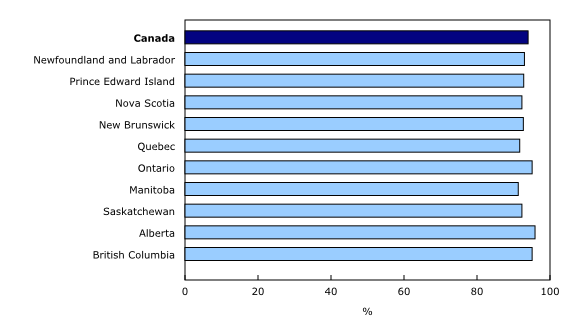Access to the Internet in Canada, 2020
Archived Content
Information identified as archived is provided for reference, research or recordkeeping purposes. It is not subject to the Government of Canada Web Standards and has not been altered or updated since it was archived. Please "contact us" to request a format other than those available.
Released: 2021-05-31
More than ever, Canadians relied on the Internet to perform various activities in their daily lives in 2020. Access to the Internet at home has become essential for many Canadians who have had to adjust the way they work, study, keep in touch with loved ones, make purchases and use online services during the COVID-19 pandemic.
More senior Canadians have home Internet access
The vast majority of Canadians (94%) had household Internet access through a fixed broadband connection in 2020. Although this proportion has remained relatively stable overall since 2018, household Internet access among those aged 65 and older increased from 79% to 83% over this period.
Approximately 6% of Canadians did not have access to the Internet at home in 2020. When asked why they did not have access, 63% reported that they had no need or interest in a home Internet connection, while 26% reported the cost of Internet service as the reason and 13% cited the cost of equipment.
Over two-thirds of Canadians have Internet download speeds of 50 megabits per second or more
For those respondents who knew their advertised Internet connection speed, 72% reported Internet download speeds of 50 megabits per second (Mbps) or more. An Internet download speed of 50 Mbps or more allows users to do online activities such as supporting multiple users at a time, streaming ultra-high-definition video with more than one connected device, or quickly downloading a high-definition movie. This indicator can be used by the Government of Canada to track its objective to make broadband connectivity with a download speed of 50 Mbps and an upload speed of 10 Mbps available to 95% of Canadians by 2026.
Divide remains depending on place of residence when it comes to Internet speed
Differences in connectivity remain, depending on where Canadians live. Nearly all Canadian households (95%) in a census metropolitan area or census agglomeration (CMA/CA) had a home Internet connection, compared with 88% of those living outside a CMA/CA.
Just over three-quarters (76%) of respondents living in a CMA/CA had an advertised download speed of 50 Mbps or more, compared with less than half of those living outside these areas (48%).
Almost half a million Canadians had a mobile data plan but no home Internet connection
Four-fifth of Canadians (80%) reported having a mobile data plan for personal use. Roughly 81% of Canadians living in a CMA/CA had a mobile data plan, compared with 73% of those living outside a CMA/CA.
Approximately 470,000 or 1.5% of Canadians reported having a mobile data plan but no home Internet connection.
Digital Economy and Society Portal
For more information, visit the Digital Economy and Society Portal, which provides data, publications, and interactive tools related to the digital economy and society in one convenient location.
Sustainable Development Goals
On January 1, 2016, the world officially began implementation of the 2030 Agenda for Sustainable Development—the United Nation's transformative plan of action that addresses urgent global challenges over the next 15 years. The plan is based on 17 specific sustainable development goals.
The Canadian Internet Use Survey is an example of how Statistics Canada supports the reporting on the Global Goals for Sustainable Development. This release will be used in helping to measure the following goals:


Note to readers
The 2020 Canadian Internet Use Survey, sponsored by Innovation, Science and Economic Development Canada, was conducted from November 2020 to March 2021.
On June 22, a more comprehensive article with additional results from the 2020 Canadian Internet Use Survey will be published in The Daily. It will focus on the adoption and use of digital technologies by Canadians, and will include topics such as Internet use, the use of Internet-connected devices, e-commerce, digital skills, security and privacy, online work, the use of digital technologies during the COVID-19 pandemic and the barriers Canadians face when using online services and digital technologies.
The survey target population covers all people aged 15 and older living in the provinces. It excludes full-time residents of institutions (namely, those residing for more than six months).
The household Internet access indicator includes only home Internet service through a fixed connection. Home Internet is typically accessed through a wireless (Wi-Fi) connection, or by using a corded connection in your home. Examples of Home Internet include a digital subscriber line (DSL), cable Internet, satellite broadband and fibre optics.
The Canadian Internet Use Survey was redesigned in 2018 and its findings should not be compared with those from previous surveys.
Census metropolitan areas are cities with a population centre of at least 100,000 and census agglomerations must have a core population of at least 10,000, based on data from the previous census.
Contact information
For more information, or to enquire about the concepts, methods or data quality of this release, contact us (toll-free 1-800-263-1136; 514-283-8300; STATCAN.infostats-infostats.STATCAN@canada.ca) or Media Relations (613-951-4636; STATCAN.mediahotline-ligneinfomedias.STATCAN@canada.ca).
- Date modified:


